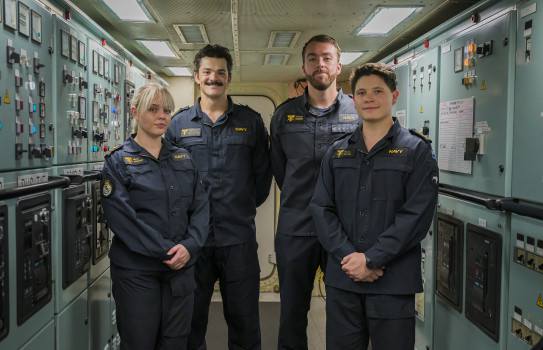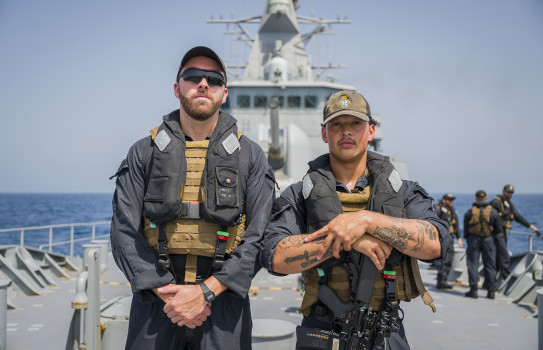I Have The Watch: Four engineers keep HMNZS Te Kaha humming
Meet four Marine Technicians who share the vital duty of Engineering Officer of the Watch aboard an Anzac frigate.
08 July, 2025
As HMNZS Te Kaha continues its mission across the Indian Ocean and the Indo-Pacific, the ship’s company can count itself fortunate to have four qualified Engineer Officers of the Watch (EOOW) on board.
Leading Marine Technicians Myer August, Chase Slaughter, Sam Norris and Henry Algar are sharing a role normally filled by a Petty Officer rank when a ship is deployed. It’s a first for the Anzac frigates since their systems upgrade (2018-2022).
An EOOW is a Marine Technician in charge of the watch in the Machinery Control Room (MCR) of a ship. They are directly responsible to the Marine Engineering Officer for the safety of all 30 members in their department, as well as the efficient running of all engineering systems controlled from the MCR.
Top of that list is the means to propel and manoeuvre the ship, centred around the 22.5 megawatt (30,000 horsepower) gas turbine engine and the ship’s two 4.4 megawatt (5,900 horsepower) diesel engines.
The EOOWs are also responsible for round the clock monitoring of essential services – propulsion, hot water, power, air conditioning, kitchen operations and sewage treatment – that keep 180 sailors happy while they live on board.

From left, LMTs Myer August, Chase Slaughter, Sam Norris and Henry Algar.
Leading Marine Technician (Propulsion) Norris says it was initially daunting to have this much machinery and personnel under his control, but he got comfortable as time when on.
“Having all four of us engineers in charge of keeping an eye on the efficient running of one of New Zealand’s most expensive moving assets, with some of the world’s most advanced military assets around us, is a pretty cool achievement and one that we will always look back on with a sense of accomplishment.”
While studying for his Control Room Watchkeeping Certificate (CRWC) he trained as a ship’s coxswain (boat driver). HMNZS Te Kaha carried out numerous boardings of vessels of interest while assigned to Combined Task Group 150 for two months in the Arabian Sea, and LMT(P) Norris was delighted to be able to take part.
“It was something I had always aspired to do on top of my engineering career, so I had to balance long days driving the ship’s RHIBs (Rigid Hull Inflatable Boat) during our work-up phase while studying the ins and outs of what makes an Anzac frigate work.”

LMT(P) Sam Norris (left) with Able Weapons Technician Hadyn Jones in their boarding party kit.
Leading Marine Technician (Electrical) Slaughter says working towards his CRWC was intimidating at first.
“My first set of Engineering Casualty Control Drills were very busy and there was a lot to take in. Now I’ve learned how to effectively manage multiple breakdowns by communicating with multiple teams at the same time, while keeping the Officer of the Watch on the bridge informed of the faults and what they have available to them.
“It still feels surreal when I think about the fact that I am a qualified EOOW on board an Anzac frigate. I have dedicated a lot of time to getting to this point in my career and have had help from many along the way.”
Learning to manage consecutive faults and keep communication flowing means a lot of pressure in the early stages of training, says Leading Marine Technician (Electrical) Algar.
“Learning doesn’t stop. Day to day, the management of the plant is never the same.
“Maintenance requirements and environmental changes challenge us to constantly adapt. The coaching and feedback I’ve received has given me the confidence to take that on every day. I’ve really widened my learning lens, and that’s part of what makes Marine Engineering a great branch to be a part of.”
Leading Maritime Technician (Electrician) August says becoming a fully qualified EOOW was the most challenging and rewarding experience of her career in the Navy.
“One of the key roles of the EOOW is to make the engineering plant safe if a defect occurs. Whether it’s in the middle of the night or while the Commanding Officer is addressing all of Ship’s Company, I will raise the alarm and make the plant safe.
“As engineers we work together as a team and I wouldn’t be where I am in my career if it wasn’t for those before me guiding me. It’s scary to think that I am now one of the engineers that I used to look up to. I still receive a lot of coaching and mentoring from those above me, but now I am trusted to pass on my knowledge to the next lot of engineers coming through the ranks.
“To be able to say I’ve accomplished all of this at the age of 25 is pretty cool.”
